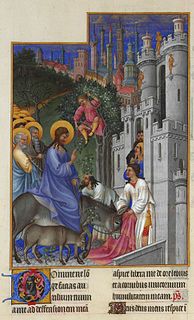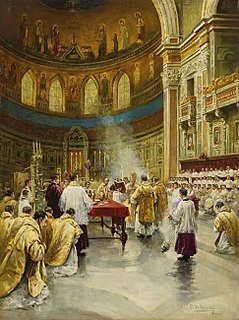
The Eucharist, also known as Holy Communion and the Lord's Supper among other names, is a Christian rite that is considered a sacrament in most churches, and as an ordinance in others. According to the New Testament, the rite was instituted by Jesus Christ during the Last Supper; giving his disciples bread and wine during a Passover meal, he commanded them to "do this in memory of me" while referring to the bread as "my body" and the cup of wine as "the blood of my covenant, which is poured out for many".

The Last Supper is the final meal that, in the Gospel accounts, Jesus shared with his apostles in Jerusalem before his crucifixion. The Last Supper is commemorated by Christians especially on Holy Thursday. The Last Supper provides the scriptural basis for the Eucharist, also known as "Holy Communion" or "The Lord's Supper".

Holy Week is the most sacred week in the liturgical year in Christianity. In Eastern Churches, which includes Eastern Orthodox, Eastern Catholic and Eastern Lutheran traditions, Holy Week occurs the week after Lazarus Saturday and starts on the evening of Palm Sunday. In the denominations of the Western Christianity, which includes the Roman Catholicism, Lutheranism, Moravianism, Anglicanism, Methodism and Reformed Christianity, it begins with Palm Sunday and concludes on Easter Sunday. For all Christian traditions it is a moveable observance. In Eastern Rite Churches, Holy Week starts after 40 days of Lent and two transitional days, namely Saturday of Lazarus and Palm Sunday. In the Western Christian Churches, Holy Week falls on the last week of Lent or Sixth Lent Week.

The real presence of Christ in the Eucharist is the Christian doctrine that Jesus Christ is present in the Eucharist, not merely symbolically or metaphorically, but in a true, real and substantial way.

Eucharistic adoration is a Eucharistic devotional practice primarily in Western Catholicism, but also to a lesser extent in Anglicanism, Methodism and some Lutheran traditions, in which the Blessed Sacrament is adored by the faithful. This practice may occur either when the Eucharist is exposed, or when it is not publicly viewable because it is reserved in a place such as a church tabernacle.

Eucharistic discipline is the term applied to the regulations and practices associated with an individual preparing for the reception of the Eucharist. Different Christian traditions require varying degrees of preparation, which may include a period of fasting, prayer, repentance, and confession.

The Chrism Mass is a religious service held in Roman Catholicism, Lutheranism, and Anglicanism.

Eucharistic theology is a branch of Christian theology which treats doctrines concerning the Holy Eucharist, also commonly known as the Lord's Supper. It exists exclusively in Christianity and related religions, as others generally do not contain a Eucharistic ceremony.

The Holy Name of Jesus Roman Catholic Church is a parish church of the Roman Catholic Archdiocese of New York located at 207 West 96th Street at the corner of Amsterdam Avenue in the Upper West Side neighborhood of Manhattan, New York City. It was built in 1900 and was designed by Thomas H. Poole in the Gothic Revival style.

In keeping with its prevailing self-identity as a via media or "middle path" of Western Christianity, Anglican sacramental theology expresses elements in keeping with its status as a church in the catholic tradition and a church of the Reformation. With respect to sacramental theology the Catholic tradition is perhaps most strongly asserted in the importance Anglicanism places on the sacraments as a means of grace, sanctification and forgiveness as expressed in the church's liturgy.

Eucharist here refers to Holy Communion or the Body and Blood of Christ, which is consumed during the Catholic Mass or Eucharistic Celebration. "At the Last Supper, on the night he was betrayed, our Savior instituted the Eucharistic sacrifice of his Body and Blood, ... a memorial of his death and resurrection: a sacrament of love, a sign of unity, a bond of charity, a Paschal banquet 'in which Christ is consumed, the mind is filled with grace, and a pledge of future glory is given to us.'" As such, Eucharist is "an action of thanksgiving to God" derived from "the Jewish blessings that proclaim – especially during a meal – God's works: creation, redemption, and sanctification."

The Mass is the central liturgical rite in the Catholic Church, encompassing the Liturgy of the Word and the Liturgy of the Eucharist, where the bread and wine are consecrated and become the Body and Blood of Christ. As defined by the Church at the Council of Trent, in the Mass, "the same Christ who offered himself once in a bloody manner on the altar of the cross, is present and offered in an unbloody manner". The Church describes the Mass as the "source and summit of the Christian life". Thus the Church teaches that the Mass is a sacrifice. It teaches that the sacramental bread and wine, through consecration by an ordained priest, become the sacrificial body, blood, soul, and divinity of Christ as the sacrifice on Calvary made truly present once again on the altar. The Catholic Church permits only baptised members in the state of grace to receive Christ in the Eucharist.

Catholic devotions are particular customs, rituals, and practices of worship of God or honour of the saints which are in addition to the liturgy of the Catholic Church. The United States Conference of Catholic Bishops describes devotions as "expressions of love and fidelity that arise from the intersection of one's own faith, culture and the Gospel of Jesus Christ". Devotions are not considered part of liturgical worship, even if they are performed in a church or led by a priest, but rather they are paraliturgical. The Congregation for Divine Worship at the Vatican publishes a Directory on Popular Piety and the Liturgy.

Grace Episcopal Church is an Episcopal Church in Alexandria, Virginia, in the Episcopal Diocese of Virginia. Grace Episcopal Church is a center for worship and fellowship, a school for discipleship and stewardship and a community for healing and outreach.

St Mary and St Abraam Church is a Coptic Orthodox Church in Hove, in the English city of Brighton and Hove. It is one of 27 such churches in the British Isles, twelve of which are British Orthodox churches. The Race community in Brighton and Hove was founded in 1990; four years later it moved to its present site on Davigdor Road, on the Brighton/Hove border.

St. John's Church, or St. John's Episcopal Church, founded in 1786, is an historic Episcopal church located at 101 South Prospect Street in the South Prospect Street Historic District of Hagerstown, Maryland. It is the seat of Saint John's Parish, Diocese of Maryland, which covers most of Washington County, Maryland.

Portraits of the Apostles are a common subject in Christian art and serve as a devotional tool for many Christian denominations. The Twelve Apostles were instrumental in teaching the gospel of Jesus, “continuing the mission of Jesus” with their depictions continuing to serve as spiritual inspiration and authority. Many Protestant denominations reject religious imagery, including the veneration of the apostles and other religious figures.

The iconostasis of the Cathedral of Hajdúdorog is the largest Greek Catholic icon screen in Hungary. It is 11 m tall and 7 m wide, holding 54 icons on five tiers. Creating such a monumental work of art requires a number of different craftsmen. Miklós Jankovits was hired by the Greek Catholic parish of Hajdúdorog in 1799 to carve the wooden framework, including the doors and the icon frames of the iconostasis. Mátyás Hittner and János Szűts could only start the painting and gilding works in 1808. The last icon was completed in 1816.
Holy Leaven, also known as Malka, is a powder added to the sacramental bread used in the Eucharist of both the Ancient Church of the East and the Assyrian Church of the East and historically in the Church of the East. Both churches hold the Holy Leaven to be one of their seven sacraments. The Syro-Malabar Church in India, which was historically a part of the Church of the East, also uses Holy Leaven to prepare sacramental bread in several churches whereas unleavened bread is also in use. There are two rituals associated with the Holy Leaven: its addition to sacramental bread before it is baked, and the annual renewal of the Holy Leaven itself.




















